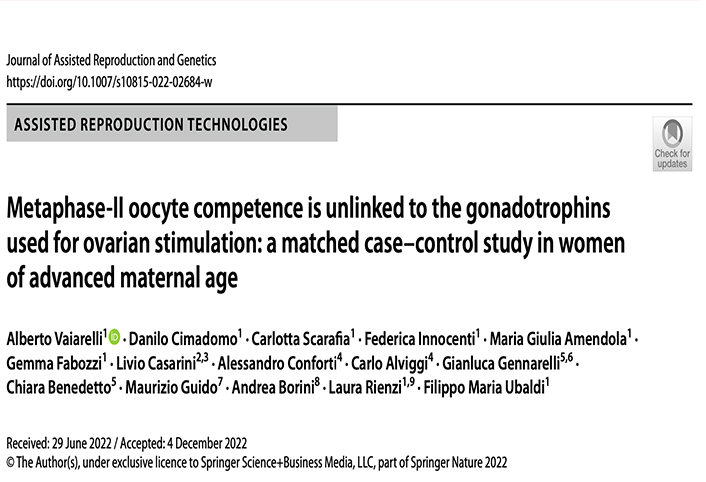
Alberto Vaiarelli, Danilo Cimadomo, Carlotta Scarafia, Federica Innocenti, Maria Giulia Amendola, Gemma Fabozzi, Livio Casarini, Alessandro Conforti, Carlo Alviggi, Gianluca Gennarelli,
Chiara Benedetto, Maurizio Guido, Andrea Borini, Laura Rienzi, Filippo Maria Ubaldi
Journal of Assisted Reproduction and Genetics https://doi.org/10.1007/s10815-022-02684-w – Received: 29 June 2022 / Accepted: 4 December 2022 / Published 31 december 2022
Abstract
Purpose An impact of different gonadotrophins selection for ovarian stimulation (OS) on oocyte competence has yet to be defined. In this study, we asked whether an association exists between OS protocol and euploid blastocyst rate (EBR) per metaphase-II (MII) oocytes.
Methods Cycles of first preimplantation genetic testing for an euploidies conducted by women ≥35 years old with the irown metaphase-II oocytes inseminated in the absence of severe male factor (years 2014–2018) were clustered based on whether recombinant FSH (rec-FSH) or human menopausal gonadotrophin (HMG) was used for OS, then matched for the number of fresh inseminated eggs. Four groups were outlined: rec-FSH (N = 57), rec-FSH plus rec-LH (N = 55), rec-FSH plus HMG (N = 112), and HMG-only (N = 127). Intracytoplasmic sperm injection, continuous blastocyst culture, comprehensive chro- mosome testing to assess full-chromosome non-mosaic aneuploidies and vitrified-warmed euploid single embryo transfers (SETs) were performed. The primary outcome was the EBR per cohort of MII oocytes. The secondary outcome was the live birth rate (LBR) per first SETs.
Results Rec-FSH protocol was shorter and characterized by lower total gonadotrophin (Gn) dose. The linear regression model adjusted for maternal age showed no association between the Gn adopted for OS and EBR per cohort of MII oocytes. Similarly, no association was reported with the LBR per first SETs, even when adjusting for blastocyst quality and day of full blastulation.
Conclusion In view of enhanced personalization in OS, clinicians shall focus on different endpoints or quantitative effects related to Gn action towards follicle recruitment, development, and atresia. Here, LH and/or hCG was administered exclu- sively to women with expected sub/poor response; therefore, we cannot exclude that specific Gn formulations may impact patient prognosis in other populations.